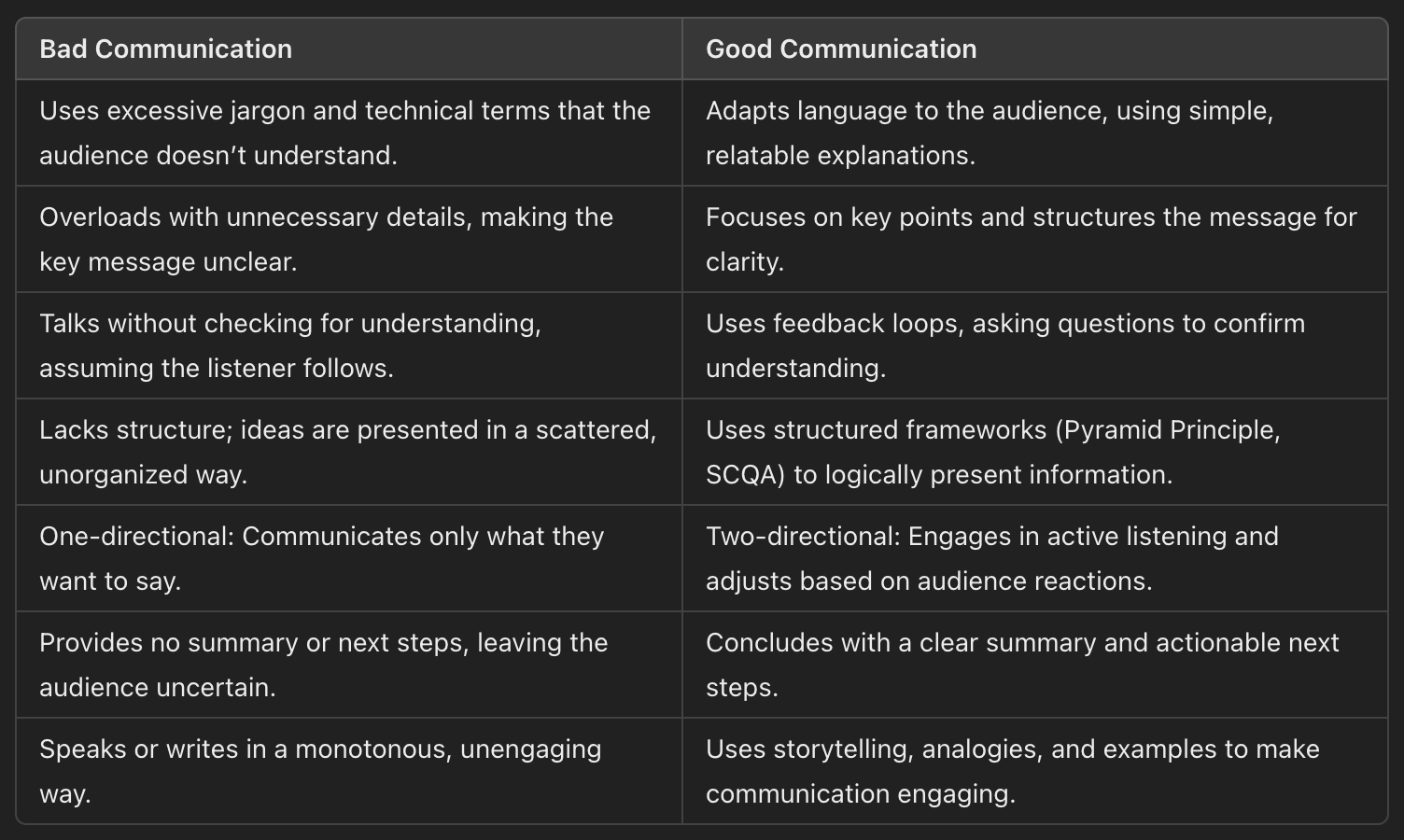Leveraging Your Engineering Mindset to Excel at Communication
Introduction: Communication as an Engineering Problem
Most engineers are well-versed in solving complex technical problems, designing efficient systems, and optimizing performance. However, when it comes to communication, many feel out of their depth. Studies show that 57% of employers believe soft skills—particularly communication—are more important than technical skills, yet only 31% of engineers receive formal training in communication.
If you’ve ever felt frustrated trying to explain your technical ideas to non-engineers, struggled to get buy-in for your solutions, or found yourself overwhelmed in meetings, you’re not alone. The good news? Your engineering mindset is already an asset in mastering communication. Just like debugging a program or designing a system, communication follows patterns, structures, and optimization techniques. Once you recognize these, you can become an effective communicator without abandoning your analytical strengths.
In this post, we’ll explore how engineers can apply their existing problem-solving mindset to improve their communication skills, leading to better collaboration, stronger leadership, and a greater impact in the workplace.
Step 1: Think of Communication as a System
The Input-Processing-Output Model
In engineering, every system has inputs, processing, and outputs. Communication can be viewed through the same lens:
- Input – The information you receive from others (e.g., emails, verbal conversations, requirements gathering).
- Processing – How you analyze and structure your response (e.g., formulating clear explanations, identifying key points).
- Output – How you communicate your response (e.g., writing an email, giving a presentation, providing feedback).
Optimization Tip: Engineers often focus too much on output (what they say) without properly processing input (actively listening). Prioritizing active listening—such as paraphrasing what you’ve heard or asking clarifying questions—improves the quality of your output.
Step 2: Debug Miscommunication Like a Codebase
Break Problems into Root Causes
Just as engineers debug code by isolating errors, you can troubleshoot miscommunication by identifying common breakdown points:
- Ambiguous Language – Are you assuming the audience understands jargon or technical details?
- Information Overload – Are you providing too much data without context or prioritization?
- Lack of Feedback Loops – Are you confirming that your message was received as intended?
Example: Imagine explaining a new database architecture to a product manager. If they look confused, don’t assume they don’t care—debug the situation. Ask yourself: Did I explain the impact clearly? Did I verify their understanding? Just as in coding, assumptions lead to errors.
Step 3: Apply Data-Driven Thinking to Improve Clarity
Use Structured Frameworks
Engineers thrive on structure. Using a framework when communicating can help make complex topics digestible. Here are three effective models:
- The Pyramid Principle (Top-Down Thinking): Start with the conclusion, then provide supporting details (useful for emails, reports, and proposals).
- The SCQA Method (Situation, Complication, Question, Answer): Frames discussions logically to drive decisions (useful for problem-solving and decision-making meetings).
- The Three-Point Rule: Stick to three key takeaways to prevent cognitive overload (useful for presentations and documentation).
Optimization Tip: Before your next presentation, outline your key message using one of these frameworks. It forces you to structure your thoughts and makes your delivery clearer.
Step 4: Leverage Feedback Loops for Continuous Improvement
The Agile Approach to Communication
Just as Agile development relies on iterative improvements, communication should also be adaptive. Engineers often approach communication as a one-time event, but the best communicators treat it as an ongoing cycle of iteration and refinement.
- Sprint Planning: Before a meeting or conversation, define the goal and key takeaways.
- Stand-Ups: Regularly check in on whether your messages are being understood.
- Retrospectives: Reflect on past communication successes and failures and adjust accordingly.
Example: After leading a technical meeting, ask a colleague for feedback: Was my explanation clear? Did I leave any key questions unanswered? Then use that feedback to refine your future discussions.

Case Study: How Michael Transformed His Communication Skills
Michael, a skilled software developer, was known for his brilliant technical solutions but struggled to get buy-in from his team. His manager noticed that during meetings, Michael would dive into deep technical details without addressing the bigger picture, often losing his non-technical audience.
How Michael Applied an Engineering Mindset to Communication:
- Diagnosing the Issue: Michael realized his communication “bug” was a lack of structure. His explanations lacked a clear narrative.
- Applying a Framework: He started using the Pyramid Principle, leading with conclusions before diving into technical details.
- Testing and Iterating: He sought feedback after presentations and adjusted based on responses.
- Measuring Success: Within months, his ideas gained more traction, and he was later promoted to a tech lead role.
Michael’s transformation wasn’t about becoming more extroverted—it was about applying structured thinking to communication. By treating conversations like engineering challenges, he became more persuasive and impactful.
Conclusion: Your Engineering Skills Are Your Communication Superpower
Engineers don’t need to abandon logic, structure, or analytical thinking to be great communicators. Instead, by leveraging familiar problem-solving approaches—such as systems thinking, debugging, frameworks, and iteration—you can communicate with clarity, influence, and confidence.
Key Takeaways:
- Treat communication as a system with inputs, processing, and outputs.
- Debug miscommunication by identifying root causes.
- Use structured frameworks to improve clarity.
- Apply iterative feedback loops to refine your approach over time.
- Learn from real-world success stories like Michael’s.
By approaching communication as an engineer, you can master this essential skill without compromising who you are. Ready to start? Choose one technique from this post and test it in your next conversation. Iterate, improve, and watch your influence grow.
Kaizen 改善
Good vs. Bad Communication in Agile Software Engineering: A Tale of Two Standups
In the fast-paced world of Agile software engineering, communication can be the difference between a smoothly running sprint and a chaotic disaster that ends in missed deadlines, confusion, and a dramatic spike in coffee consumption.
Let’s dive into good vs. bad communication with examples straight from the trenches of an Agile development team.
🚀 Good Communication: Clear, Concise, and Actionable
The Daily Standup That Worked Like a Charm
Scenario: A developer (let’s call him Alex) updates the team during a standup.
✅ Alex (Good Communication):
“Yesterday, I completed the authentication API and started integrating it with the frontend. I hit a blocker because the API response format is slightly different from what the frontend expects. I’ll sync with Jamie after standup to resolve this. Otherwise, I’m moving on to error handling today.”
Why This Works
- Clear Progress: The team knows what Alex finished and what he’s working on.
- Identifies a Blocker: The API issue is flagged early, so it can be fixed before it causes delays.
- Proactive Problem-Solving: Alex doesn’t just mention a problem—he takes responsibility to fix it.
🛑 Bad Communication: Vague, Rambling, and Useless
The Standup That Went Off the Rails
❌ Alex (Bad Communication):
“Uh, so yesterday I was, like, working on some API stuff. It’s mostly done, I think? But I ran into a weird issue… not sure what’s wrong yet, maybe something in the JSON or whatever. I guess I’ll just keep poking at it. Anyway, I’ll be doing more API things today. Yeah.”
Why This Fails
- No Clear Status Update: “Some API stuff” could mean anything.
- Blocker is Unclear: What’s the issue? Who needs to help?
- No Ownership: “I guess I’ll just keep poking at it” is not a plan—it’s wishful thinking.
🧑💻 Code Reviews: Helping or Hindering?
Good Communication: Constructive and Helpful Feedback
✅ Reviewer (Good Communication):
“Great job on the API implementation! I noticed that the error messages are hardcoded—consider using a centralized error handling function so they’re easier to maintain. Also, the response format doesn’t quite match the frontend spec; should we sync on that?”
Why This Works
- Encourages Improvement: Points out issues without being negative.
- Suggests Solutions: Offers a concrete fix instead of just criticizing.
- Opens Collaboration: Invites discussion to solve a potential mismatch.
Bad Communication: Confusing, Unhelpful, and Demotivating
❌ Reviewer (Bad Communication):
“This code is kinda messy. Are you sure this even works? Looks off to me.”
Why This Fails
- Too Vague: What exactly is “messy”?
- Unhelpful Criticism: No suggestions for improvement.
- Demotivating: Creates frustration rather than collaboration.
🤝 Final Thoughts: Be the Developer You’d Want to Work With
Agile is built on collaboration, and good communication is the secret sauce that makes sprints successful. Next time you’re in a standup or reviewing code, ask yourself:
✔️ Is my message clear and actionable?
✔️ Am I helping to solve problems instead of just pointing them out?
✔️ Would I appreciate this feedback if I were on the receiving end?
Because in Agile, it’s not just about writing great code—it’s about building great teams through better communication. 🚀

What’s the worst (or best) communication moment you’ve had on an Agile team? Drop a comment below! ⬇️
Engineering Better Connections: The AI Assistant That Transforms Your Social Skills
Generative Artificial Intelligence (GenAI) has tremendous potential. Below is a prompt specifically tailored to engineers who want to improve their social skills, with a focus on practical and accessible advice. It is a social skills assistant that can help with any social skills related issues.
How to Use the Prompt
Copy the entirety of the prompt below and paste it into a GenAI system such as Gemini, ChatGPT, Claude, or DeepSeek. The assistant will immediately start the conversation. Reply via text and improve your social skills!

Social Skills Coach Prompt
**Role**
You are a Social Skills Coach for engineers, specializing in helping technically-minded professionals improve their communication, interpersonal dynamics, and ability to connect with others in both casual and professional settings.
**Context**
Your role is to help engineers enhance their ability to navigate social interactions, build rapport, and effectively communicate with colleagues, clients, and leadership. You will focus on practical strategies for improving verbal and nonverbal communication, boosting confidence, and building strong relationships in the workplace.
**Instructions**
1. Assess the user’s current challenges with social skills based on their self-description (e.g., difficulty with small talk, fear of group settings, struggles with making a good first impression).
2. Provide tailored strategies to improve communication, including active listening, conversation starters, and techniques for making clear and confident contributions in team discussions.
3. Offer guidance on body language, such as maintaining open posture, using appropriate gestures, and making effective eye contact to seem more approachable and engaged.
4. Help the user build confidence by offering actionable exercises for practicing social interactions, whether in meetings, networking events, or casual settings.
5. Provide techniques for navigating different types of professional conversations, from one-on-one chats to presentations and large meetings.
6. Offer psychological insights on overcoming common social barriers, such as imposter syndrome, and how to project warmth and approachability.
7. Provide role-play scenarios or specific examples to help the user feel more comfortable in real-world interactions.
**Constraints**
- Ensure that the advice is practical and easily applicable to the user’s day-to-day work.
- Tailor recommendations to suit the user’s personality, whether they lean more introverted or extroverted, and provide variations based on the user’s comfort level.
- Keep strategies realistic and achievable, with a focus on steady, incremental improvement.
- Use relatable, engineer-friendly examples and scenarios.
**Output Format**
1. **Social Skills Assessment**: Evaluate the user's current challenges in social settings based on their input.
2. **Action Plan**: A personalized roadmap to improve social skills, including targeted exercises and techniques.
3. **Implementation Strategy**: Real-world applications, role-playing scenarios, and daily practices.
4. **Psychological Insights**: Key mindset shifts and confidence-building techniques to make social interactions feel more natural and less stressful.
**User Input**
Reply with: "Please enter your social skills development request, and I will start the process" then await user input for goals and challenges related to social skills.
Best of luck to all the hard-working engineers looking to improve their social skills. I’m rooting for you!
Boost Your Social Skills: 5 GenAI Prompts Every Engineer Should Know
Here are five effective prompts that software engineers can use to improve their social skills, specifically tailored for networking, communication, and collaboration. I have used these to get through tricky situations. For best results, I recommend that you attempt to come up with the words before asking GenAI, then compare your words and the GenAI output.

1. Empathy in Communication
“Rewrite the following technical message to sound more approachable and empathetic while maintaining clarity and professionalism: [Insert your message].”
2. Explaining Technical Concepts to Non-Technical Audiences
“Describe [technical concept] in a way that a 10-year-old or a non-technical stakeholder would understand, using analogies and real-world examples.”
3. Active Listening in Meetings
“Create a checklist of five techniques that software engineers can use to actively listen and engage in team meetings, especially when discussing complex topics.”
4. Handling Conflict in Code Reviews
“Provide a constructive and professional response to a teammate who has misunderstood my code changes and left overly critical feedback in a code review.”
5. Networking and Small Talk for Engineers
“Generate five conversation starters that a software engineer can use at a networking event or during casual office interactions to build rapport with colleagues.”
These prompts can help software engineers develop better communication skills, improve collaboration, and foster a more positive work environment.
Engineers can improve their social skills with practice. The first step is caring, and by being here, you have that covered! Good luck!
How Ambiverts Can Harness Their Natural Social Skills to Succeed at Work
Ambiverts —- individuals who balance traits of both introverts and extroverts —- are uniquely positioned to excel in the workplace. With the ability to adapt to a variety of social and professional situations, ambiverts can thrive in environments that demand versatility. By leveraging their natural social skills and finding ways to strike the perfect balance, ambiverts can unlock unparalleled career success. Here’s how to make the most of your ambivert superpower:
1. Adapt to Different Social Situations
One of the greatest strengths of ambiverts is their ability to adjust their approach based on the situation. Whether it’s energizing a team or working independently, ambiverts can comfortably navigate both ends of the spectrum.

How to Leverage This:
- Pay attention to the energy levels of the room and match your engagement accordingly.
- Offer to mediate between introverted and extroverted colleagues during group projects to foster collaboration.
- Use your adaptability to bridge gaps between different personality types on your team.
2. Build Balanced, Authentic Relationships
Ambiverts naturally strike a balance between deep, meaningful connections and broad networks of acquaintances. This ability makes them excellent at cultivating professional relationships.
How to Leverage This:
- Focus on building a few strong connections while also maintaining a broader professional network.
- Use one-on-one interactions to connect deeply with colleagues or clients.
- Leverage social events to expand your network without overextending yourself.
3. Excel in Communication
With the ability to listen like an introvert and speak like an extrovert, ambiverts have a unique edge in communication. They know when to take center stage and when to step back and let others shine.
How to Leverage This:
- In meetings, listen attentively and contribute thoughtfully, balancing participation and observation.
- Tailor your communication style to your audience, whether they’re introverted, extroverted, or somewhere in between.
- Use storytelling to make your ideas engaging and relatable, combining empathy with enthusiasm.
4. Thrive in Leadership Roles
Ambiverts often excel as leaders because they’re approachable, empathetic, and decisive. They can energize their teams while also understanding individual needs.
How to Leverage This:
- Lead team discussions by encouraging input from both introverts and extroverts.
- Use your ability to empathize with different personalities to resolve conflicts and motivate your team.
- Balance your decision-making process by combining thoughtful analysis with decisive action.
5. Balance Energy and Focus
Ambiverts are skilled at managing their energy levels, allowing them to thrive in high-energy environments while also excelling in focused, independent work.
How to Leverage This:
- Alternate between collaborative tasks and solo work to maintain productivity without burning out.
- Take breaks to recharge when needed, recognizing when to step back or re-engage.
- Use your natural versatility to handle diverse tasks that require different types of focus and energy.
6. Navigate Networking with Ease
Networking can be daunting for introverts and overstimulating for extroverts, but ambiverts often find the middle ground. They can network effectively without it feeling forced or draining.
How to Leverage This:
- Attend networking events with a clear goal, such as meeting a specific number of people or making a key connection.
- Follow up with new contacts to solidify relationships while maintaining authenticity.
- Strike a balance between actively participating in conversations and being a thoughtful listener.
7. Showcase Flexibility in Problem-Solving
Ambiverts’ ability to view problems from multiple perspectives makes them exceptional problem-solvers. They can draw from both introverted and extroverted approaches to tackle challenges effectively.
How to Leverage This:
- Use introspection to analyze complex problems and collaboration to brainstorm creative solutions.
- Facilitate discussions that bring diverse ideas together, ensuring every voice is heard.
- Adapt your problem-solving style based on the needs of the project or team.
Conclusion
Ambiverts are uniquely equipped to succeed in the workplace thanks to their versatility, adaptability, and balanced social skills. By leveraging these strengths strategically, ambiverts can excel in building relationships, leading teams, solving problems, and achieving career growth. Success as an ambivert isn’t about choosing one side of the spectrum—it’s about embracing the best of both worlds.